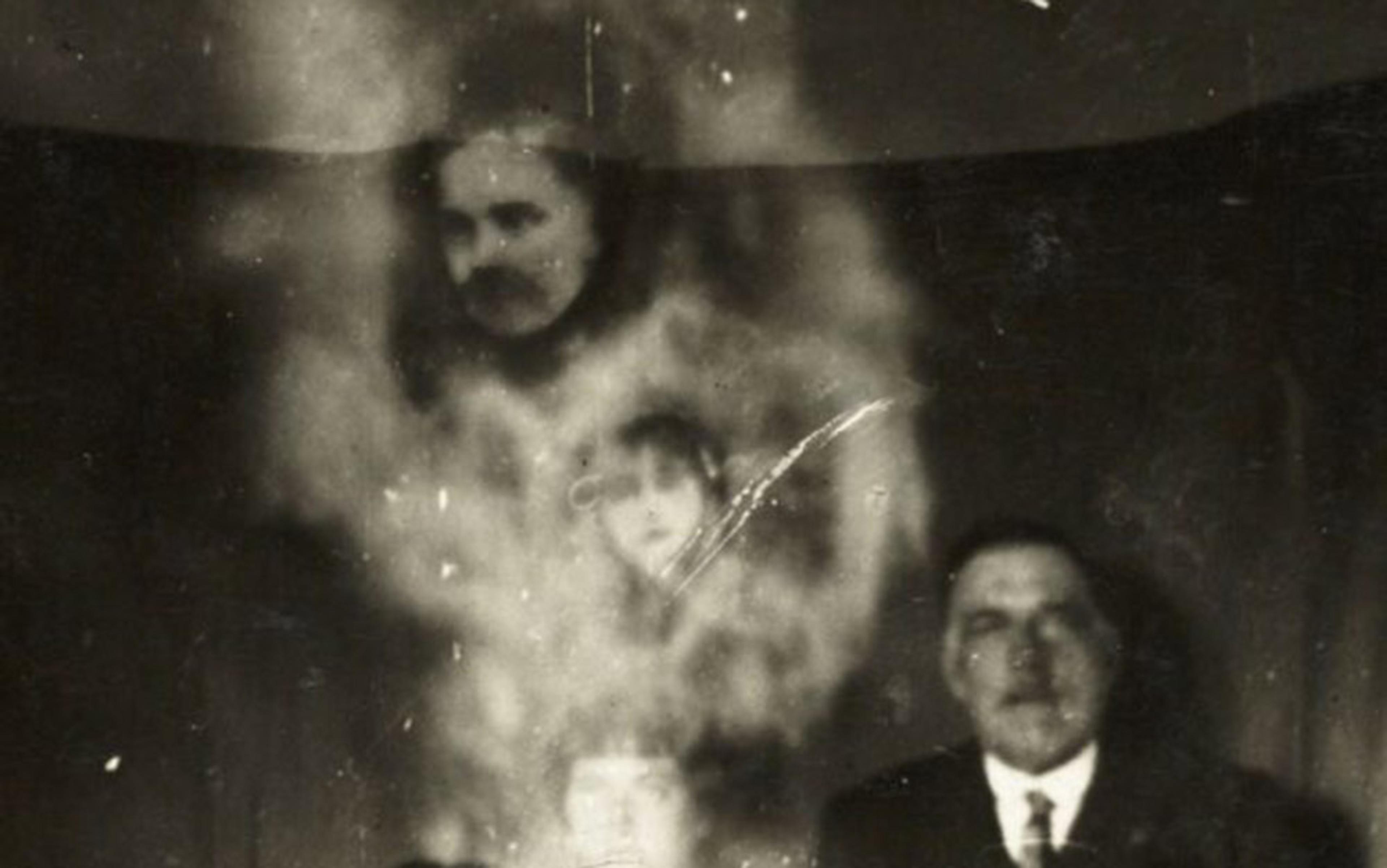For a moment the Canterville ghost stood quite motionless in natural indignation … There was evidently no time to be lost, so, hastily adopting the Fourth Dimension of Space as a means of escape, he vanished through the wainscoting, and the house became quite quiet.
The Canterville Ghost (1887) by Oscar Wilde
Johann Zöllner, a German physicist who studied optical illusions, could not believe his eyes. He had carefully prepared a rigorous test of the powers of the so-called spiritualist medium Henry Slade. By sealing both ends of a set of ropes and placing them on a tabletop under keen observation, there was no way that they could have been tied together. Yet, as clear as day, in front of other scientific witnesses – including the electrodynamics expert Wilhelm Weber and the noted philosopher Gustav Fechner – four knots had suddenly appeared where none had been.
In 1879, the same year that the great physicist James Clerk Maxwell died and Albert Einstein was born, Zöllner published Transcendental Physics, a treatise attempting to explain how Slade performed the knot trick and other magical feats, such as removing wooden rings from a long cord, making solid objects disappear and reappear, and ‘summoning’ writing on untouched empty slates. Such acts, Zöllner concluded, were performed through access to the fourth dimension.
In Zöllner’s view, based on his readings of the German philosopher Immanuel Kant and the German mathematician Carl Gauss, the fourth dimension was as real as the three dimensions of space. Due to their prejudices, Zöllner thought, most people don’t perceive the fourth dimension, but they could if they were properly trained or had the natural gift Slade seemed to have.
Zöllner had ample precedent for reaching this seemingly audacious conclusion. The roots of connecting higher dimensions with a transcendental realm date back at least to Plato’s cave allegory, in which prisoners confined to a cavern observe two-dimensional shadows on a wall while being unaware of the three-dimensional world outside that produced them. But although Plato implied that we three-dimensional beings might be likewise oblivious to a greater reality, he didn’t explicitly argue that there was an actual fourth dimension.
A more immediate antecedent to Zöllner’s hypothesis is found in The Unseen Universe, a popular book published anonymously in 1875, and later revealed to have been co-authored by the Scottish mathematical physicists Balfour Stewart and Peter Guthrie Tait (a lifelong friend of Maxwell). The treatise speculates about links between scientific concepts such as conservation of energy and spiritual questions such as the persistence of life after death. In one brief passage, it connects the fourth dimension with an unseen realm:
Just as points are the terminations of lines, lines the boundaries of surfaces, and surfaces the boundaries of portions of space of three dimensions: so we may suppose our (essentially three-dimensional) matter to be the mere skin or boundary of an Unseen whose matter has four dimensions.
Zöllner knew enough about optical illusions to posit similarly that space’s restriction to three dimensions could simply be a persistent mirage. Perhaps, then, the world of the spirit, including all manner of psychic occurrences, had a perfectly natural explanation in a hitherto unexplored dimension. Goaded by the widespread interest in spiritualism at the time, Zöllner delved into connections between higher dimensions and the occult with greater gusto than anyone prior to him had dared. It was high time, he concluded, for the study of four-dimensional phenomena to be part of science.
Certain fringe groups, such as the Theosophical Society and the Society for Psychical Research (co-founded by Stewart), applauded this thesis, and began to promote the concept of the fourth dimension as a spiritual realm in their writings. Overall, however, Zöllner did not get the positive reaction he had sought from the mainstream scientific community. He was supported by only a handful of scientists – among them the British naturalist Alfred Russel Wallace – and ignored or mocked by the vast majority.
Despite Zöllner’s lack of mainstream support, his purported connection between higher dimensions and the paranormal proved astonishingly appealing, to the point that it has become an integral part of modern culture. From the psychedelic vibes of 1960s rock groups such as the 5th Dimension to the maudlin sentiments of the film Interstellar (2014) – ‘Maybe [love] is an artifact of a higher dimension that we can’t consciously perceive’ – unseen dimensions continue to convey powerful otherworldly connotations.
Modern physicists working on higher-dimensional models have been forced to address that connotation – either by refuting it, or by giving it a subtle nod to make an exotic hypothesis (such as the multiverse) sound more enticing. Hence the predicament of how to address the spiritual association with higher dimensions that began in earnest with Zöllner and Slade persists to this day.
One of Zöllner’s harshest contemporary critics was his colleague at the University of Leipzig, Wilhelm Wundt, widely considered the father of psychology. Wundt witnessed some of Slade’s feats and dismissed them as parlour tricks. He pointed out German grammatical errors in supposed messages from the beyond that Slade had revealed on his slates. Zöllner, who had supported Wundt for his academic position, was incensed by the attacks.
The scientific community’s cynicism toward Zöllner’s thesis was amplified by a London trial held in October 1876 that had called into question Slade’s credibility. Slade – a charismatic young American who had brought his practice to England after years of gaining a reputation for his slate-writing séances throughout the United States – had been arrested and charged with fraud. By accepting financial contributions for his channelling of ‘messages from the beyond’, he was accused of swindling the bereaved.
One of the key witnesses in the trial was Sir Edwin Ray Lankester, a renowned British zoologist. Lankester had studied under Thomas Huxley, nicknamed ‘Darwin’s bulldog’ for his vocal advocacy of evolution, and he similarly expressed his views loudly and clearly. As Huxley once described his protégé:
Lankester … is helping me as Demonstrator in a course of instruction in Biology which I am giving to Schoolmasters – with a view of converting them into scientific missionaries to convert the Christian Heathen of these islands to the true faith.
Like Huxley, Lankester had become a leading champion for constructing rock-solid scientific arguments as a bulwark against unproven bunk. For that reason, he was eager to rip Slade’s methods to shreds. Pretending to have a deceased relative, he arranged for Slade to conduct a séance. Before the so-called medium could summon a ‘supernatural communication’, Lankester grabbed the slate from under the table and showed that the message had already been written on it. His testimony had been key to Slade’s arrest.
By parading a notorious charlatan as a sage of higher dimensions, he opened the floodgates of ridicule
Slade was convicted and sentenced to three months of hard labour, but his attorney appealed on the basis of a procedural error and got him released. While awaiting a new trial, Slade fled to continental Europe, where he ended up in the scientific embrace of Zöllner.
By parading such a notorious charlatan as a sage of higher dimensions, Zöllner opened the floodgates of criticism and ridicule. For example, on 17 November 1880, a biting satire of Zöllner’s hypothesis appeared in The New York Times:
[Zöllner] has decided that inasmuch as he cannot explain the marvels which he witnessed in Slade’s presence by any hypothesis resting on known natural laws, they must inevitably be the work of intelligent but invisible beings dwelling in the fourth dimension of space. This postulate not only fully explains all the so-called phenomena of Spiritualism, but it explains a great deal more … Why does a piece of bread and butter, when dropped on the floor, fall, in nine cases out of 10, with its buttered side underneath? … The fourth-dimensional imps exercise an influence which is irresistibly felt by … bread and butter.
Wilde’s early tale The Canterville Ghost similarly mocked the popular association of higher dimensions with the supernatural. At one point in the story, the beleaguered spirit that is the central character flees into the fourth dimension as a means of escape. Wilde winked to an audience undoubtedly familiar with the Slade trial or at least with controversial aspects of Zöllner’s purported link between the fourth dimension and the occult.
In the mid-1880s, despite (or perhaps because of) the Slade trial and the prominence of quasi-mystical groups such as the Society for Psychical Research and the Theosophical Society, several mathematicians published works trying to explain four-dimensional realms as realistic possible extensions of the known physical world. Their writings drew heavily on an analogy by Gauss, who imagined how a bookworm confined to flat pages would perceive the three-dimensional world as ‘unreal’ until informed otherwise.
The most famous of these works was Flatland (1884) by the British mathematician Edwin A Abbott, headmaster at the City of London School. Flatland envisions how a society of geometric beings confined to a flat plane would react to an incursion from the three-dimensional realm. When ‘A Square’ (a clever play on words based on Abbott’s second and third initials being identical), the protagonist, encounters a Sphere passing through his plane, he sees it only as a growing or shrinking circle. He does not accept that the Sphere is a visitor from a hitherto unseen extra dimension until it whisks him out of the plane and offers him a panoramic view of his native land, including the insides of his friends and neighbours, as revealed from a previously unimagined direction: above.
After A Square is returned to Flatland, he begins to preach the ‘Gospel of the Three Dimensions’, but everyone thinks he’s insane. Locked up in an asylum, he writes his memoirs in the hope of persuading future generations of the reality of a higher dimension. ‘I am absolutely destitute of converts,’ he says. ‘Yet I exist in the hope that these memoirs, in some manner, I know not how, may find their way to the minds of humanity in Some Dimension, and may stir up a race of rebels who shall refuse to be confined to limited Dimensionality.’ That line aptly sums up the dismal attitude toward higher dimensions among Abbott’s peers.
Einstein’s general theory of relativity enabled physicists to reclaim higher dimensions from the spiritualists
Around the time that Flatland appeared, another British mathematician, Charles Howard Hinton, published a series of books – some whimsical, others more pedagogical – aspiring to explain to the public how to envision the fourth dimension. Howard coined the term ‘tesseract’ to describe the four-dimensional analogues of a cube, with eight cubic sides instead of six square faces. He then invited readers to contemplate the projections (shadows) and slices of such objects within familiar space. It is directly analogous to Abbot’s flat square attempting to comprehend the form of a three-dimensional sphere. It also echoes Plato’s analogy of the cave, lending an air of classical authority.
Other late-19th-century mathematicians began to imagine the fourth dimension as something far more familiar: the passage of time. The pages of Nature and other scientific journals featured speculations about a four-dimensional amalgam of the three-dimensions of space along with an additional dimension of time. These notions eventually received a concrete mathematical treatment in Einstein’s general theory of relativity, which enabled physicists to reclaim higher dimensions from the spiritualists. Long before then, though, they left their own imprint on popular culture.
H G Wells took note of the idea of a temporal fourth dimension when setting the stage for the Time Traveller’s journey in his novella The Time Machine (1895). Before setting off on his voyage into the distant future, the Time Traveller explains to his friends that time is simply another dimension. As he elucidates:
There are really four dimensions, three which we call the three planes of Space, and a fourth, Time. There is, however, a tendency to draw an unreal distinction between the former three dimensions and the latter, because it happens that our consciousness moves intermittently in one direction along the latter from the beginning to the end of our lives.
The trope of navigating through time the way that we navigate through space has been a staple of fiction ever since. If anything, it seems more widespread than ever today.
In 1905, when Einstein proposed the special theory of relativity as a way of reconciling Maxwell’s prediction that the vacuum speed of light is invariant with the classical mechanics notion that speeds are relative, the fourth dimension was not at all on his mind. Although his theory predicted that motion could distort both the measure of space and the flow of time, Einstein treated the spatial and temporal parameters distinctly.
Yet two years later, the Russian-German mathematician Hermann Minkowski, who had been one of Einstein’s professors at the ETH (Swiss Federal Institute of Technology), showed that Einstein’s theory could be expressed far more elegantly if space and time were combined into a unified four-dimensional entity called ‘spacetime’. At the 80th Assembly of German Natural Scientists and Physicians, held in 1908 in Cologne, Minkowski proclaimed his spacetime theory in the manner of a revolutionary decree:
The views of space and time which I wish to lay before you have sprung from the soil of experimental physics, and therein lies their strength. They are radical. Henceforth, space by itself, and time by itself, are doomed to fade away into mere shadows, and only a kind of union of the two will preserve an independent reality.
Einstein found Minkowski’s formulation too abstract, and resisted using it for two full years. In the meantime, though, Einstein’s colleagues in Germany such as Max von Laue and Arnold Sommerfeld began to employ the powerful four-dimensional framework. Finally, in a lecture on relativity delivered in January 1911, Einstein conceded that Minkowski’s formalism was superior and easier to use than his own. Without his embrace of four-dimensional spacetime, Einstein would surely have faced a much more difficult path to the general theory of relativity, his masterful way of describing gravitation through geometry, completed in 1915.
They connect higher dimensions – newly respectable due to Einstein – back to older pseudoscientific ideas
At least part of Einstein’s initial resistance to making use of the fourth dimension had to do with its association with the supernatural, which he thought would confuse non-mathematicians. In the chapter ‘Minkowski’s Four-Dimensional Space’, in his textbook Relativity: The Special and General Theory (1916), it is telling that Einstein begins his exposition by dismissing that connection:
The non-mathematician is seized by a mysterious shuddering when he hears of ‘four-dimensional’ things, by a feeling not unlike that awakened by thoughts of the occult. And yet there is no more commonplace statement than that the world in which we live is a four-dimensional spacetime continuum.
Einstein’s concerns were well-founded. Throughout the early decades of the 20th century, references to links between higher dimensions and mystical phenomena continued to appear in various media. For example, on 28 September 1911 the Ellensburg Capital, a newspaper based in the state of Washington, published a front-page article headlined ‘The Fourth Dimension’ claiming that intoxication stimulated the pineal gland and enabled drunkards to see four-dimensional shapes. As the article states:
The shapes which the layman believes the patient only imagines are really seen and are rendered visible through the excitation of the pineal gland, which now is the rudimentary organ of what once was psychic vision.
Even the sober New York Times published an article – ‘Seeks a New Sense by “Pineal Eye”: Engineer Hopes Development of Gland in Brain Will Aid in Comprehending Fourth Dimension’ (1930) – that seriously considered purported connections between the pineal gland (known in mystical circles as the ‘third eye’) and the fourth dimension. These pieces attempted to connect higher dimensions – newly respectable due to Einstein – back to older pseudoscientific ideas about seeing things beyond the normal limits of human perception.
Well after Einstein embraced the fourth dimension as time, the mystical view of the fourth dimension persisted. In 1923, the influential Spanish-American philosopher George Santayana wrote:
Understanding [the supernatural] must be bought … at the price of escaping into a fourth dimension.
The horror writer H P Lovecraft, an enthusiast of Santayana’s works, again summoned the association between higher dimensions and the supernatural in his tale ‘The Dreams in the Witch House’ (1933). In it, a physics student named Walter Gilman discovers, via a series of frightening dreams, that the spooky house he is living in contains a portal to the fourth dimension crafted by a witch through her prescient knowledge of non-Euclidean geometry. Lovecraft stirred both science and superstition into his cauldron of terror:
Possibly Gilman ought not to have studied so hard. Non-Euclidean calculus and quantum physics are enough to stretch any brain, and when one mixes them with folklore, and tries to trace a strange background of multi-dimensional reality behind the ghoulish hints of the Gothic tales and the wild whispers of the chimney-corner, one can hardly expect to be wholly free from mental tension.
As the concept of spacetime became an integral part of physics, the fourth dimension began to lose its spooky edge. Scientists began to turn their attention to the realistic possibility of a fifth dimension. Nevertheless, higher dimensions continued to appear as common elements of horror stories and pop mysticism.
Inspired by the work of the physicists Theodor Kaluza, Oskar Klein and others, in the 1930s Einstein sought a way of making use of a compact fifth dimension (curled up so tightly that it cannot be observed) as a way to unify two of the natural forces, gravitation and electromagnetism. He remained averse to the idea of higher dimensions, and took the leap only after exhausting other possibilities for unification. As Einstein wrote in a 1938 paper, co-authored with the physicist Peter Bergmann:
If Kaluza’s attempt is a real step forward, then it is because of the introduction of the five-dimensional space. There have been many attempts to retain the essential formal results obtained by Kaluza without sacrificing the four-dimensional character of the physical space. This shows distinctly how vividly our physical intuition resists the introduction of the fifth dimension. But by considering and comparing all these attempts one must come to the conclusion that all these endeavours did not improve the situation. It seems impossible to formulate Kaluza’s ideas in a simple way without introducing the fifth dimension. We have, therefore, to take the fifth dimension seriously although we are not encouraged to do so by plain experience.
They still hold that clairvoyance and telekinesis transpire via a dimension beyond known space and time
As scientists moved on to the fifth dimension, so too did old-style believers in the extrasensory perception of a ‘higher realm’. Consider the opening lines spoken by Rod Serling on the late-1950s/early 1960s science-fiction TV series The Twilight Zone:
There is a fifth dimension beyond that which is known to man. It is a dimension as vast as space and as timeless as infinity. It is the middle ground between light and shadow, between science and superstition, and it lies between the pit of man’s fears and the summit of his knowledge. This is the dimension of imagination. It is an area which we call the Twilight Zone.
The scientific legitimacy of unseen higher dimensions, established by general relativity, proved durable. Today, the topic of higher dimensions is a mainstream, albeit controversial, aspect of physics, due to unification attempts such as string theory and M-Theory. Theorists talk casually of up to seven extra dimensions of reality. Experimenters seek evidence of such unseen avenues in particle collision data from the Large Hadron Collider. Although most physicists eschew any spiritual connotations of higher dimensions, perhaps in some cases that mystique – as expressed in books such as The Dancing Wu Li Masters (1979) by Gary Zukav – has helped to draw new recruits to the genuine science.
For believers in the occult, the association between higher dimensions and psychic insights persists, however. More than a century after Slade was exposed as a charlatan, there are still many adherents to the idea that clairvoyance, telekinesis and other types of supernatural connections transpire by means of a dimension beyond known space and time. Documentaries with titles such as Angel, Alien and UFO Encounters from Another Dimension (Sound Line Media Group, 2012) find audiences eager to project onto unseen dimensions their far-flung dreams of contact with extraterrestrials, heavenly beings and the deceased.
Much as Einstein found himself compelled to consider higher dimensions, today’s physics community has concluded that progress in unifying the forces of nature could well depend on models that include more than four dimensions. Experimentalists are striving with ardour to either rule them in or rule them out. These ideas do not come without some lingering cultural baggage, though, and some researchers have expressed dismay at their findings being exaggerated, misconstrued, or even used to promote pseudoscience.
No wonder Einstein was so cautious in embracing higher dimensions. He knew that any higher-dimensional theory could be misinterpreted, and open the floodgates to all manner of superstitious belief. Perhaps his essence is looking down at us from the five-dimensional astral realm and having a good chuckle.






